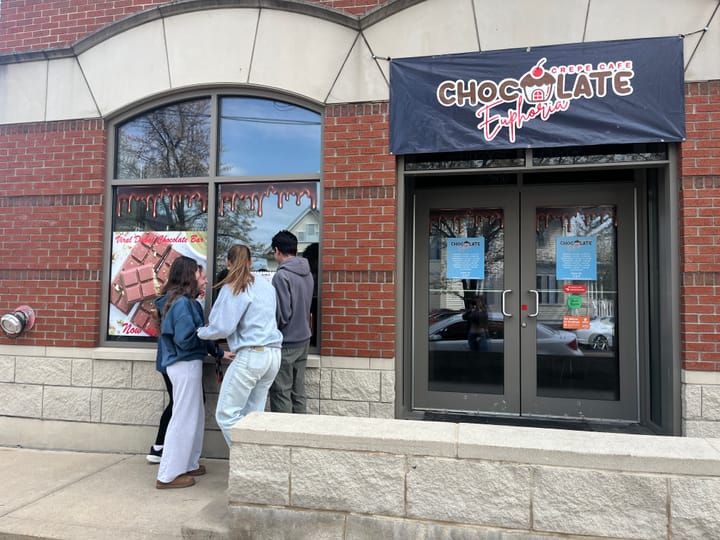As Trump’s anti-immigration policies take hold, locals find support in each other
Immigrants in Oxford have turned to family and friends for community in the past year as Donald Trump has promised mass deportations. One local lawyer says deportations at the scale President Trump has promised will face massive logistical problems.

Last weekend, President Donald Trump invoked wartime powers from the 1790s to deport hundreds of Venezuelan immigrants, sending them to El Salvador.
The move capped off two months of aggressive action from the Trump Administration on immigration enforcement that began on his first day in office with an executive order to end birthright citizenship. Like that first order, many of Trump and his administration’s actions have faced legal challenges in court.
A federal judge last weekend ordered the administration to halt its deportation of alleged Venezuelan gang members for two weeks, “but the administration did it anyway” and failed to comply with an order to turn planes around, according to reporting by NPR. Trump then referred to the judge as a “Radical Left Lunatic” and called for his impeachment, earning a rebuke from Supreme Court Chief Justice John Roberts.
While Trump’s actions have drawn condemnation and constitutional questions, his rhetoric has created a climate of fear with tangible results. U.S. Customs and Border Protection reported less than 12,000 encounters at the Mexican border in February, a drastic decrease from more than 60,000 in January. The agency reported an average of nearly 180,000 encounters per month in 2024.
Locally, immigrants are working to build community, even as they say some politicians have done their best to make all immigrants feel unwelcome.
Coming to America for a better life
At age 16, Cristóbal Solorzano began a journey of more than 1000 miles across Mexico to reach the U.S. border, alone.
It was 2023, and he was running away from his home in Guatemala. If Solorzano had stayed in his home country, he said, his educational and work opportunities would have been severely limited. A 2023 report by the U.S. Embassy in Guatemala found that the country had numerous “significant human rights issues.”
“When I arrived at the frontier between Mexico and the U.S., I handed myself in to immigration,” he recalled. He was 17 by the time he reached the U.S., and he spent three days in a detention facility before going to Pecos Children’s Center, a housing facility for unaccompanied migrant children. The facility had previously been closed due to reports of poor living conditions but was reopened in 2023 as border crossings spiked, CBS News reported at the time.
In the years since then, Solorzano has come to live in Oxford with John-Charles Duffy and Hugo Olaiz, who is himself an immigrant. While Solorzano has legal status and is on a waiting list to apply for residency now, Trump’s hardline rhetoric has made it difficult for any immigrants to feel safe.
“My country was a disaster … so I came to this country believing that it was a free democracy, more stable,” Solorzano said. “They sell you all this stuff in the movies that America is the top of the triangle … but now it feels a lot of uncertainty. I think it’s outrageous that you can’t rely on the public figures that you have in government, the fact that your own president says things that then he backs up on every week.”
That rhetoric exists locally, too. Butler County Sheriff Richard Jones has repeatedly attracted national media attention for his views on illegal immigration. He recently re-installed a sign outside the Butler County Jail that reads “Illegal Aliens Here.” The jail used to have a contract with Immigration and Customs Enforcement (ICE) to house ICE detainees, and Jones renewed that agreement this year. Jones was unavailable for an interview with the Oxford Free Press.
Republican Congressman Warren Davidson represents Butler County but did not respond to a request for comment. According to Davidson’s website, he opposes “quick-fixes like granting amnesty to people who’ve illegally entered our country” and supports a stronger border and “reforming U.S. policy surrounding birthright citizenship and federally funded welfare programs.”
The logistical challenges of deportation
Trump has promised the largest mass deportation in U.S. history, but the logistics of such an operation are complex. In 2024, ICE had the capacity to house roughly 45,000 detainees at a time, enough for less than 0.5% of people in the U.S. illegally.
Michael Brandabur is an immigration lawyer in Butler County. While Trump’s rhetoric is inflammatory, Brandabur said immigration concerns have consistently ebbed and flowed throughout U.S. history.
Just as Trump invoked a law from 1798 to deport alleged Venezuelan gang members, immigration law is full of obscure provisions that can be hard to sort out. In one case, for example, Brandabur recalled helping a client who seemed to have an unwinnable case — until Brandabur learned that he had Native American heritage. Based on the Jay Treaty of 1794, some Native Americans entering the U.S. from Canada are entitled to unrestricted access.
“It is the most complex area of U.S. law,” Brandabur said. “It is wildly inconsistently applied, so I always tell clients, ‘You can count on several things in immigration: zero common sense, and zero consistency.’ That’s the only consistent thing about it.”
There are structural barriers to mass deportation, too. Citizens and noncitizens alike are granted due process in the U.S., but the country has just 700 immigration judges spread across 71 immigration courts.
All cases in southwest Ohio have to go through Cleveland, and the sheer volume of cases can lead to a process of a decade or more in some cases, Brandabur said. He was recently in Cleveland for a case and learned that one of Ohio’s immigration judges left the bench, adding to the backlog.
“They were reallocating that judge’s caseload,” Brandabur said. “That was 7 thousand cases that judge had.” The total number of pending cases surpassed 4 million in early 2025, coming out to an average of more than 5,500 cases per immigration judge.
People on all ends of the political spectrum understand that the U.S. immigration system has structural failures, Brandabur said, but the country is too reliant on migrant labor to expel everyone in the U.S. illegally.
Immigration, religion and building community
Olaiz came to the U.S. from Argentina for graduate school in 1990 and overstayed his student visa. He and Duffy lived together at North Carolina for a time, but the state didn’t allow same-sex marriage. They traveled to Washington D.C. for a civil marriage, but it wasn’t until Obergefell v. Hodges legalized same-sex marriage federally that Olaiz could apply for citizenship.
During Trump’s first term, Olaiz helped make a bilingual pamphlet for the Episcopal Church entitled “No Longer Strangers: Exploring Immigration Issues.” Faith has been an important part of his life, especially as a lens to view social issues through.
“Part of the context was the idea of talking about the issue instead of avoiding it,” Olaiz said. “The truth is that even the Episcopal Church, which is a very progressive church, not 100% of the people are necessarily on board with the fact that immigrants should have the right to stay if they have certain visas or if they are undocumented.”
Immigration policy raises a number of important religious principles, Olaiz said. For him, those include supporting children by keeping families together and treating strangers with compassion.
Duffy was born in the U.S. and is an assistant teaching professor of comparative religion at Miami University. He said the current role of religion in politics has created a disconnect between religious leaders who endorse immigration reform and congregations where many people take a more hardline stance.
“We have conservative churches we conservative leaders and conservative members, and it becomes much easier for them to mobilize around the issue,” Duffy said. “It’s harder, I think, for something like the Catholic Church or the Episcopal Church to talk about immigration and actually get members mobilized around it, because the reality is that a lot of the members, they’re not really on the same page on the missions around some of these issues.”
Beyond church, Solorzano has done his part to help bring people together. Last summer, he led an informal class to help both documented and undocumented immigrants learn English, with help from Duffy.
The idea started after Solorzano went on a retreat with the Episcopal Church and met Latino people from different states. He knew of many immigrants in and around Oxford, particularly in the hospitality and restaurant industries, and said they were enthusiastic to learn.
“I started writing words on a paper and putting it in the kitchen of the restaurant, so during my shift, I would teach them some words,” Solorzano said. “Of course, my boss didn’t like that much because I was supposed to be working. So what I did is that I used the resources of our church … to start a summer class for my Latino coworkers.”
Even though Solorzano feels embedded in the community, and Duffy and Olaiz feel safe in Oxford, the fear caused by the Trump administration has reached them. Solorzano said the friends he’s made, the education he’s gotten and the work he’s done has all been with the aim of assimilating to U.S. culture, even if that’s not enough for some people to accept his presence today.
“I’ve been working in the community as much as I can to somehow show that I’m worth existing in this space and time,” Solorzano said. “And yet, I’m still not — for a big part of the country, not for all of them — fitting in, or not worth keeping in the country.”




